Understanding the Sponsorship Cycle in Bodybuilding Events
Sponsorship in bodybuilding competitions is vital for ensuring financial support and growth opportunities for athletes. The cycle typically begins with identifying potential sponsors who align with the sport’s values and audience. Not all sponsors are suitable; they need to understand the niche market. Bodybuilding sponsors include fitness brands, nutritional supplement companies, and gym equipment manufacturers. A thorough research process can help identify the best matches between brands and competitions. Engaging sponsors involves presenting compelling proposals that highlight audience demographics, competition visibility, and benefits for sponsors. Essential components of a good proposal include statistics on viewership, past sponsor success stories, and innovative promotional strategies. Utilizing both digital channels and physical engagement during events can significantly enhance sponsor visibility, urging them to invest. After securing sponsorships, establishing clear communication is key to ensure expectations are met. Regular updates on event evolutions keep sponsors in the loop. Creating impactful collaborations often leads to long-term relationships, cultivating loyalty. The conclusion of the event should include a reporting phase where outcomes are shared with sponsors, detailing their return on investment to build trust.
The Importance of Brand Alignment
Choosing sponsors in bodybuilding events requires a keen eye for brand alignment. It’s crucial for sponsors to resonate with the values and ethos of the sport. Brands should focus on authenticity, ensuring that their message aligns with the audience’s passions. If a supplement company, for example, appropriately markets to bodybuilders, it enhances credibility. Alignment fosters a trustworthy relationship, encouraging athletes to proudly wear sponsor logos while competing. This relationship benefits both sides: sponsors gain exposure, and athletes gain resources. The right partnership can also enhance the event’s prestige. When a well-known brand sponsors an event, it elevates its profile, attracting more competitors and fans. Furthermore, participants are likely to associate their performance with a reputable brand, boosting morale. Competitive bodybuilders are increasingly brand-conscious; they look for sponsors who genuinely support their journeys. The sponsorship could also include incentives like product discounts, thereby building loyalty. By understanding each other’s values, both brands and athletes thrive together. This mutually beneficial relationship not only brings financial support but also promotes a cohesive image, ensuring a successful outcome for everyone involved.
Once sponsorship agreements are established, maintaining effective communication is crucial for all participants. Consistent engagement fosters a healthy atmosphere, enabling sponsor feedback and suggestions to enrich the event experience. Bodybuilding competitions thrive on planning and execution, so sponsors should be brought into the loop during preparations. Regular updates can encompass various aspects, such as promotional activities, marketing strategies, and logistical challenges. Providing sponsors with insight into event marketing efficiency can help them adapt their strategies accordingly. Additionally, establishing a collaborative relationship where sponsors can contribute ideas encourages investment. Event organizers should understand the sponsor’s expectations deeply; they should not overlook the significance of aligning goals. Create opportunities for sponsors to engage directly with competitors, thereby enhancing the connection. Sponsors may also wish to run workshops or demonstrations, which can mutually benefit both parties. After the commitment phase, it’s vital to keep communication channels open post-event, ensuring sponsors receive comprehensive coverage along with innovative marketing ideas. Feedback collection aids in understanding what went well, and what could require refinement, allowing for continued partnership development.
Metrics and Performance Evaluation
Evaluating performance after the event is fundamental in assessing the impact of sponsorship. Collecting metrics regarding visibility, engagement, and sales provides an overview for sponsors. Utilizing various metrics, event organizers can gauge sponsorship effectiveness accurately. These might include social media impressions, participation rates, and media mentions. Surveys distributed to attendees help collect qualitative feedback. Gathering such feedback provides insights into audience perceptions of sponsors. Recording sales data during the event offers concrete proof of sponsorship value. Both parties need to value these metrics as they guide future sponsorship decisions. Presenting findings relating to brand exposure to sponsors can enhance rapport and encourage reinvestment. Moreover, case studies showcasing successful sponsorships can form persuasive evidence for potential sponsors. Building a strong portfolio of case studies can advise sponsors on their choices. Clear reporting also behaves as a strategic tool, assuring sponsors of their investment’s return. Metrics should not only evaluate past performance but also identify opportunities for growth. By analyzing results collaboratively, sponsors and event organizers can adapt and refine their strategies for future bodybuilding competitions.
A critical element in the sponsorship cycle is creating promotional opportunities that benefit both sponsors and athletes involved in bodybuilding competitions. Events can incorporate various platforms, such as social media, print, and on-site advertising, to showcase sponsorship brands. Promoting sponsors through athletes wearing branded gear during competitions maximizes visibility. Additional strategies include utilizing digital marketing visual assets that attract audience engagement. For example, creating highlight reels featuring both competitors and sponsors can add excitement to promotions. Engaging content can go viral, increasing sponsors’ reach dramatically. Event organizers can also facilitate sponsor booths at competitions, creating opportunities for direct interaction. This not only enhances brand interaction but also provides valuable consumer insights. Moreover, leveraged partnerships for promotional giveaways during competitions can entice greater audience participation. Athletes showcasing sponsor products in action can drive sales effectively. Properly executed promotional strategies lead to wider market visibility and foster loyal brand communities. Utilizing innovative advertising solutions encourages a dynamic and creative approach to sponsorship. Both sponsors and athletes can experience the advantages of well-executed promotional opportunities, ultimately solidifying the sponsorship cycle.
The Future of Sponsorship in Bodybuilding
As the bodybuilding industry continues to evolve, so does the landscape of sponsorship opportunities. With the rise of digital media, many opportunities exist for partners to explore interactive platforms. Sponsorship can now extend to virtual events, social media challenges, and influencer collaborations. Future bodybuilding competitions are expected to incorporate technology, enhancing audience engagement and attracting new sponsors. Innovations can include live streaming events where sponsors can be featured prominently for maximum visibility. Additionally, brands might seek to collaborate with top athletes, influencers, and coaches who can effectively promote their products. Embracing technology can also assist in engaging remote audiences, ensuring that geographical limitations do not hinder sponsorship success. Moreover, health and wellness trends can influence the type of sponsors looking to invest in bodybuilding competitions. As audiences become more health-conscious, brands that reflect these values will gain more interest. Consequently, emerging industries such as tech-based fitness solutions may offer new sponsorship avenues. Keeping up with these trends ensures sustained growth, allowing companies and athletes to thrive collaboratively in a competitive landscape.
Sponsorship also presents an opportunity for exhibitors at bodybuilding competitions to expand their reach. By participating in these competitions, companies can tap into a targeted audience eager for information about products. This direct engagement allows brands to showcase their offerings. Engaging attractions can include interactive booths, product samples, and live demonstrations. By participating in such events, brands gain insights into customer preferences and trends. Moreover, personal interactions foster brand loyalty. Exhibitors can form relationships with bodybuilders and enthusiasts alike, facilitating increased sales in the long term. Additionally, competitions offer a platform for launching new products. Whenever possible, brands should leverage high-profile events to maximize visibility. However, aligning product launches with key events requires careful timing and coordination. Too late to market can result in missing target demographics. Collaboratively marketing strategies with event organizers can ensure integrated plans, thus increasing excitement. Gasps from anticipated showcases can build hype, captivating the audience. A win-win for both exhibitors and athletes lies in synergistic partnerships that ensure collective growth. Ultimately, strategic sponsorships can pave the way for a vibrant community that enhances the experience.
In summary, sponsorship opportunities in bodybuilding competitions are crucial for the growth and evolution of the sport. Understanding the cycle from recruiting sponsors to evaluating their performance can lead to mutual benefits. Effective collaboration and alignment between sponsors and bodybuilders can pave the way for innovative partnerships. As the industry continues to adapt to new trends and digital advancements, it’s vital for all stakeholders to remain proactive. Communication, clear metrics, and promotional strategies ensure that each partner maximizes their investment. Future opportunities lie in embracing technology and understanding the audience’s needs, allowing brands to take advantage of the shifting landscape. Careful planning and shared goals enhance the relationship between brands and athletes throughout the process. The next frontier in bodybuilding sponsorship includes exploring unique engagement strategies, building loyalty, and fostering community connections. By adapting to these changes and staying focused on mutual growth, sponsorships can galvanize a new era in bodybuilding. Those in the industry must study successful models, adapting to find new ways to engage. By continuing to innovate within this sphere, all participants can achieve greater heights and larger audiences.


